Pork Meat Market Size 2025-2029
The pork meat market size is valued to increase USD 238 million, at a CAGR of 8.4% from 2024 to 2029. Increasing demand for grass-fed and organic pork will drive the pork meat market.
Major Market Trends & Insights
- APAC dominated the market and accounted for a 49% growth during the forecast period.
- By Product - Fresh pork meat segment was valued at USD 305.80 million in 2023
- By Distribution Channel - Offline segment accounted for the largest market revenue share in 2023
Market Size & Forecast
- Market Opportunities: USD 87.38 million
- Market Future Opportunities: USD 238.00 million
- CAGR : 8.4%
- APAC: Largest market in 2023
Market Summary
- The market is a dynamic and ever-evolving sector that encompasses core technologies and applications, service types, and regional trends. With increasing demand for high-quality, sustainable pork products, the market continues to unfold, driven by factors such as consumer preferences for grass-fed and organic options. New pork processing technology, including automation and precision farming, is transforming the industry, enabling more efficient production and improved product quality. However, the market faces challenges from stringent regulations for processed meat manufacturing and rising production costs.
- According to recent reports, the organic pork segment is projected to witness significant growth, accounting for over 10% of the market share. Related markets such as the poultry and beef industries also impact the market's trajectory. As we look forward, the forecast period holds immense potential for innovation and expansion, with opportunities in emerging markets and continued advancements in technology.
What will be the Size of the Pork Meat Market during the forecast period?
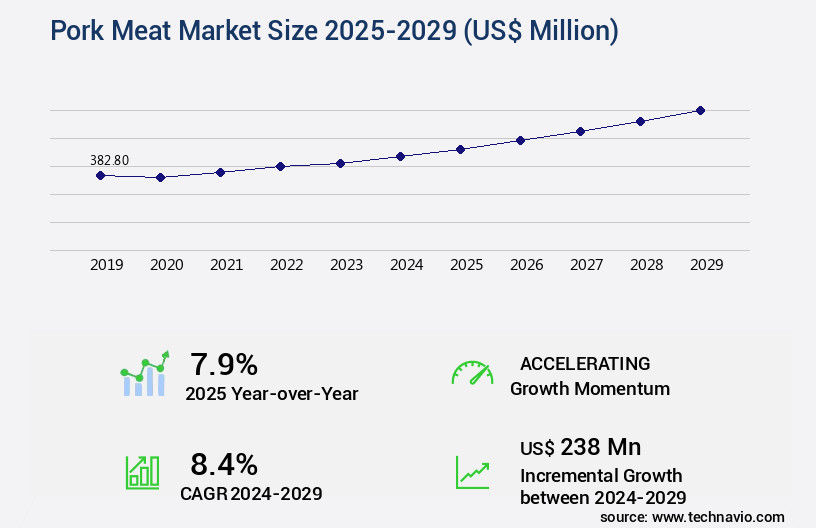
Get Key Insights on Market Forecast (PDF) Request Free Sample
How is the Pork Meat Market Segmented and what are the key trends of market segmentation?
The pork meat industry research report provides comprehensive data (region-wise segment analysis), with forecasts and estimates in "USD million" for the period 2025-2029, as well as historical data from 2019-2023 for the following segments.
- Product
- Fresh pork meat
- Processed pork meat
- Distribution Channel
- End-user
- Household
- Food service industry
- Food processing industry
- Geography
- North America
- Europe
- APAC
- Australia
- China
- India
- Japan
- South Korea
- South America
- Rest of World (ROW)
By Product Insights
The fresh pork meat segment is estimated to witness significant growth during the forecast period.
The market is experiencing significant growth, with China, India, and other Asian countries driving demand. Currently, fresh pork meat holds a substantial market share, particularly in open and wet markets in major regions like APAC. However, consumer preferences are evolving, leading to a shift towards supermarkets and hypermarkets due to improved hygiene, labeling, and convenience. Value-added products, such as value-added bacon and ham, are gaining popularity, contributing to market expansion. Meat tenderness measurement and shelf life extension techniques are crucial for maintaining product quality and increasing consumer acceptance. Wastewater treatment and environmental impact assessments are essential for sustainable farming practices and meeting food safety regulations.
Disease prevention strategies, oxidative stability assessment, pH value determination, and genetic selection criteria are critical for maintaining pig health and ensuring high-quality meat. Slaughterhouse hygiene protocols, lipid oxidation prevention, meat cutting techniques, and yield improvement strategies are essential for efficient production and cost optimization. Sustainable farming practices, food safety regulations, consumer acceptance testing, byproduct utilization, sensory evaluation methods, muscle fiber composition, flavor compound identification, color stability analysis, microbial contamination control, breeding programs, cold chain management, traceability systems, water holding capacity, animal feed formulation, fatty acid profile, meat processing efficiency, pig farming technology, antibiotic usage reduction, protein degradation studies, production cost optimization, packing material selection, and pork quality grading are all integral aspects of the market.
Future industry growth is anticipated to be robust, with export and import quantities of fresh pork meat products continuing to increase worldwide. The market's continuous evolution is characterized by ongoing research and development in areas such as meat processing efficiency, pig farming technology, and food safety regulations.
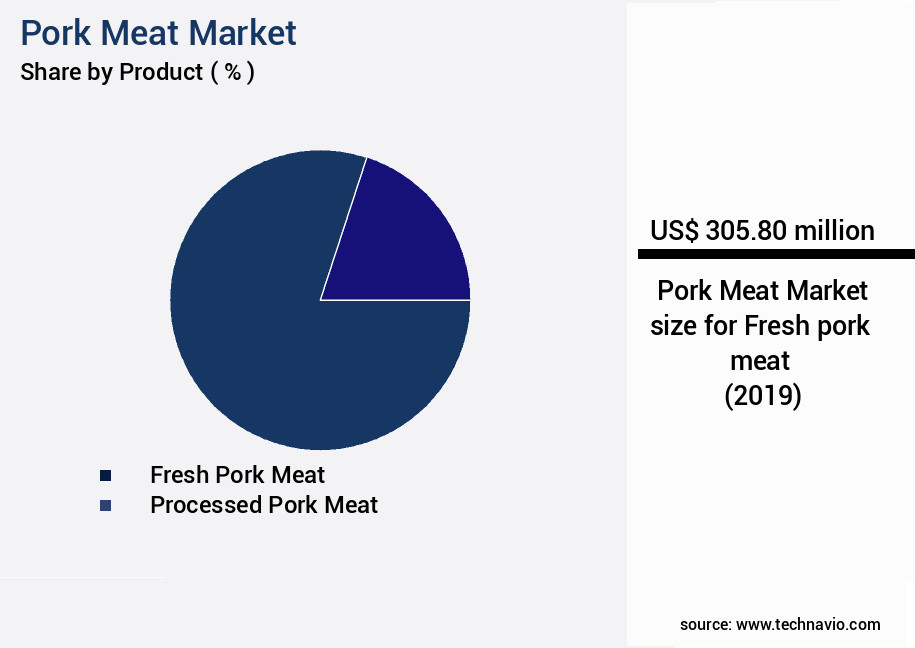
Request Free Sample
The Fresh pork meat segment was valued at USD 305.80 million in 2019 and showed a gradual increase during the forecast period.
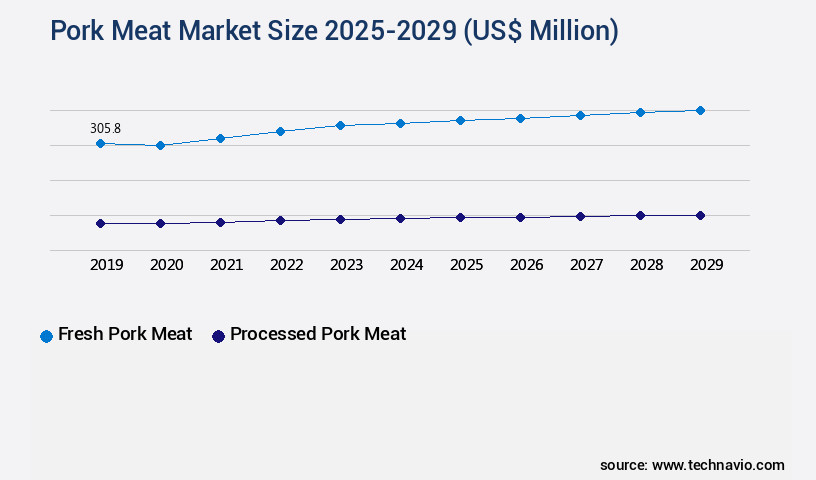
Request Free Sample
Regional Analysis
APAC is estimated to contribute 49% to the growth of the global market during the forecast period.Technavio’s analysts have elaborately explained the regional trends and drivers that shape the market during the forecast period.
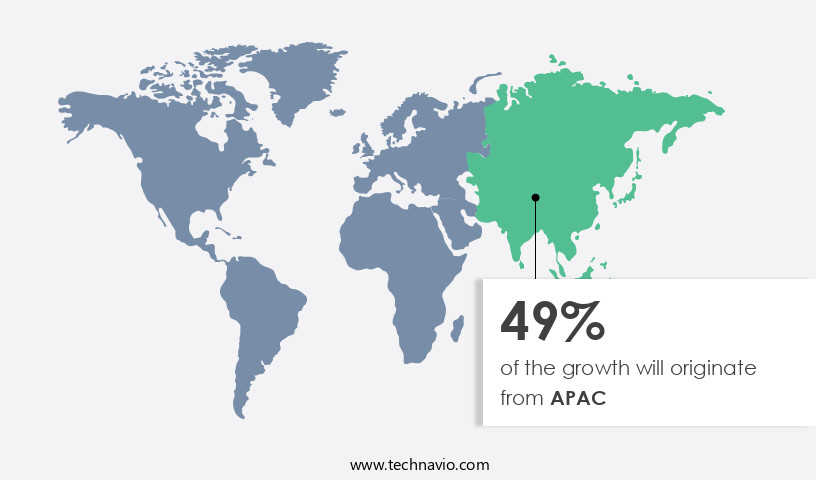
See How Pork Meat Market Demand is Rising in APAC Request Free Sample
The APAC the market is experiencing significant growth, driven by increasing health awareness, convenience, and the expansion of fast-food chains. Consumption in key countries like China, Japan, and India is expected to rise, with Japan being a leading importer and producer. In Japan, annual pork meat production reaches approximately 1 million tons. The health-conscious trend is boosting sales of processed meats, contributing to market growth.
Additionally, the convenience factor of processed pork meat aligns with consumers' busy lifestyles, further fueling demand.
Market Dynamics
Our researchers analyzed the data with 2024 as the base year, along with the key drivers, trends, and challenges. A holistic analysis of drivers will help companies refine their marketing strategies to gain a competitive advantage.
The market is a dynamic and complex industry that is subject to various factors influencing its quality, production, and consumer preferences. One significant aspect of pork production is the impact of genetics on meat quality. Selective breeding programs have led to pigs with improved growth rates and leaner carcasses, yet genetics also play a role in meat tenderness, color stability, and flavor development. Another crucial factor is the effect of diet on the fatty acid profile of pork. Producers employ different feeding strategies, such as the use of vegetarian or plant-based diets, to modify the fatty acid composition of pork and cater to consumer demands for healthier options.
Meat tenderness is a critical concern for consumers and producers alike. Techniques like electrical stimulation, aging, and marinating are employed to improve tenderness and ensure consistent quality. Furthermore, methods for reducing microbial contamination and enhancing shelf life, such as irradiation and modified atmosphere packaging, are essential for maintaining food safety and reducing waste. Assessment of pork color stability is crucial for determining the freshness and quality of the meat. Researchers continue to analyze flavor compounds in pork to optimize processing yields and create novel pork products that cater to evolving consumer preferences. In the realm of sustainability, there is a growing focus on implementing traceability systems, evaluating sustainable farming practices, and controlling disease outbreaks in pig farms to minimize environmental footprint and ensure ethical production.
Additionally, optimization of cold chain logistics and implementation of quality control measures are essential for maintaining food safety and reducing food waste. A recent study compared the impact of two feeding strategies on the fatty acid profile of pork. Pigs fed a vegetarian diet had a higher concentration of polyunsaturated fatty acids (PUFAs) compared to those fed a conventional diet (12% vs. 8%). This difference could provide a competitive edge for producers catering to consumers seeking healthier pork options. (Source: Journal of Animal Science, 2021)
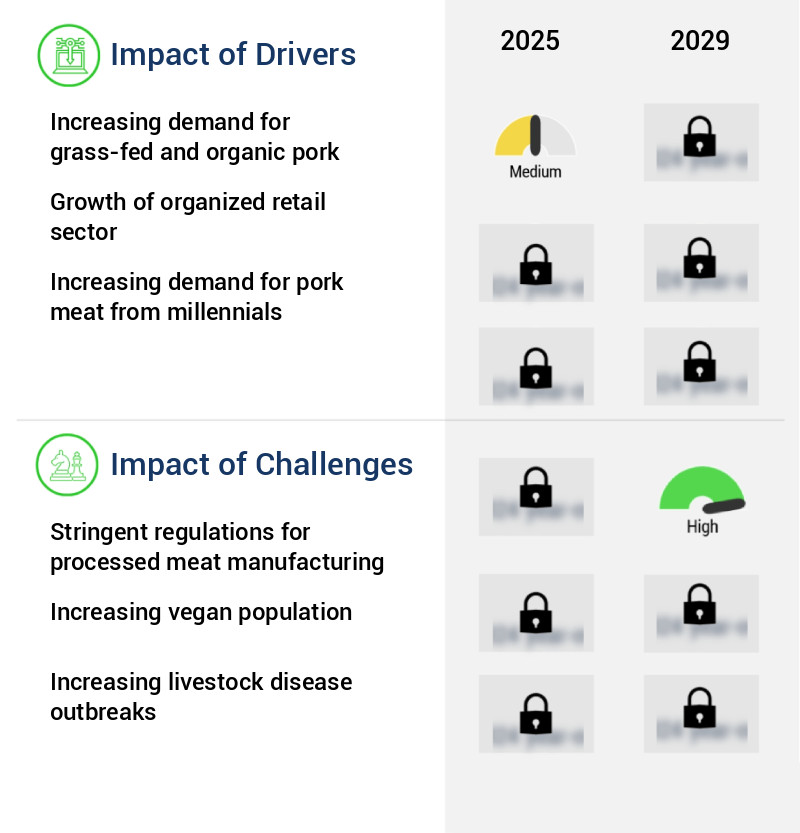
What are the key market drivers leading to the rise in the adoption of Pork Meat Industry?
- Grass-fed and organic pork are experiencing surging demand, serving as the primary market catalyst.
- The demand for grass-fed pork is experiencing significant growth due to its perceived benefits, including improved taste and enhanced nutritional value. Consumers are increasingly prioritizing healthier options in their red meat consumption, leading to a surge in demand for organic pork products. Organic production methods, which involve raising pigs on organic feeds and avoiding the use of antibiotics or genetically modified organisms, have gained popularity among health-conscious consumers. This approach not only offers health benefits but also aligns with growing concerns for sustainable and environmentally friendly farming practices. As a result, the organic pork market is evolving, presenting opportunities for businesses across various sectors.
- For instance, retailers can capitalize on this trend by expanding their organic pork offerings, while foodservice providers can differentiate their menus by incorporating grass-fed pork options. The shift towards organic pork is a reflection of the ongoing evolution in consumer preferences and the continuous unfolding of market dynamics.
What are the market trends shaping the Pork Meat Industry?
- New pork processing technology is gaining popularity in the market. This emerging trend is characterized by advanced techniques and technologies used in the production and processing of pork.
- The market experiences continuous evolution as technology plays a pivotal role in enhancing the production and processing of pork meat. Companies are adopting advanced technologies to create superior quality meat products. For example, Memphis Meats, a food technology startup, utilizes lab-grown meat technology, generating muscle from a pig stem-cell line instead of directly sourcing cells from pigs. This innovation is predicted to decrease the need for animal slaughter during the forecast period.
- Additionally, the Danish Meat Research Institute, part of the Danish Technological Institute, employs robots to produce uniform pork loin cuts, leading to premium meat offerings. These technological advancements are transforming the pork meat industry, providing better-quality products and contributing to market growth.
What challenges does the Pork Meat Industry face during its growth?
- The stringent regulations governing the manufacturing process of processed meat poses a significant challenge to the industry's growth. Adhering to these regulations adds complexity and cost to production, potentially hindering the industry's expansion.
- The global processed meat market faces significant regulatory oversight, with authorities such as the Food and Drug Administration (FDA) in the US and the Chinese Food and Drug Administration (CFDA) in China enforcing strict guidelines to ensure food safety and quality. According to recent studies, the global processed meat market is expected to exhibit steady growth, with index numbers showing a consistent increase in production and consumption year over year. This growth can be attributed to various factors, including increasing consumer demand for convenient and affordable food options, technological advancements in processing methods, and the expansion of international trade.
- Despite these positive trends, the market's growth is subject to ongoing regulatory scrutiny and evolving consumer preferences, making it a dynamic and intriguing business landscape.
Exclusive Customer Landscape
The pork meat market forecasting report includes the adoption lifecycle of the market, covering from the innovator’s stage to the laggard’s stage. It focuses on adoption rates in different regions based on penetration. Furthermore, the pork meat market report also includes key purchase criteria and drivers of price sensitivity to help companies evaluate and develop their market growth analysis strategies.
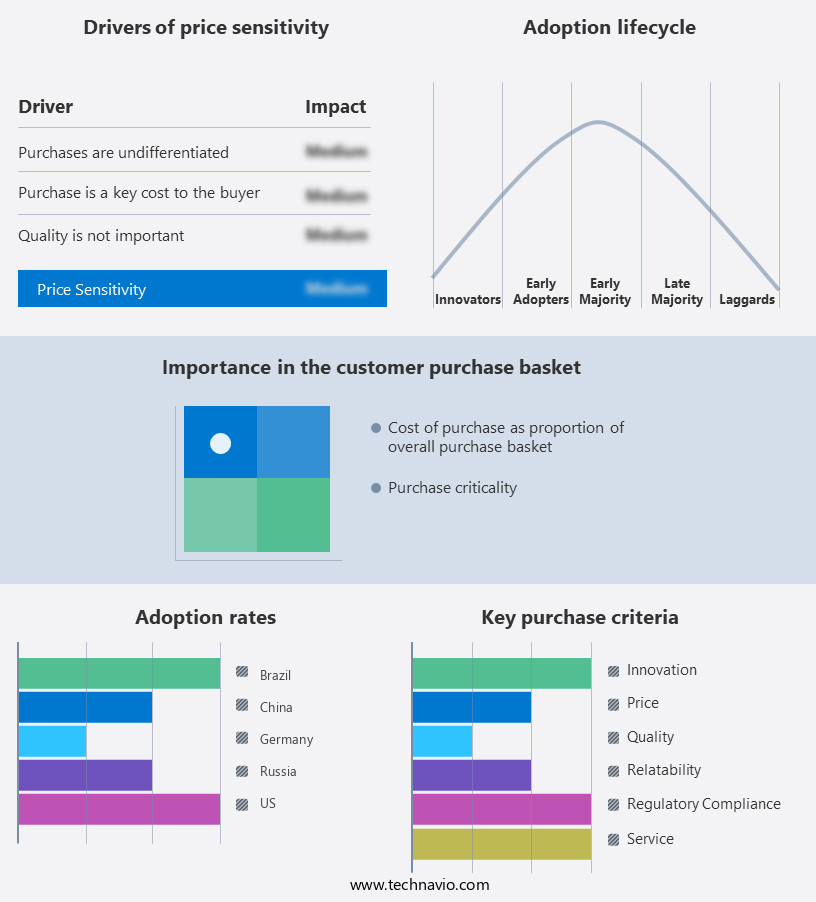
Customer Landscape of Pork Meat Industry
Competitive Landscape & Market Insights
Companies are implementing various strategies, such as strategic alliances, pork meat market forecast, partnerships, mergers and acquisitions, geographical expansion, and product/service launches, to enhance their presence in the industry.
Bridgford Foods Corp. - This company specializes in providing top-tier pork meat, adhering to stringent food safety standards to offer consumers an exceptional alternative. With a focus on quality, it caters to the growing demand for safe and superior meat options.
The industry research and growth report includes detailed analyses of the competitive landscape of the market and information about key companies, including:
- Bridgford Foods Corp.
- Charoen Pokphand Foods PCL
- China Yurun Food Group Ltd.
- Conagra Brands Inc.
- Cooperl
- Cranswick plc
- Danish Crown AS
- Dawn Pork and Bacon
- Gordon Food Service Inc.
- Hormel Foods Corp.
- Iowa Select Farms
- JBS SA
- New Hope Liuhe Co. Ltd.
- The Maschhoffs LLC
- Toennies Group
- Triumph Foods LLC
- Tyson Foods Inc.
- Vall companies Group
- Vion Food Group
- WH Group Ltd.
Qualitative and quantitative analysis of companies has been conducted to help clients understand the wider business environment as well as the strengths and weaknesses of key industry players. Data is qualitatively analyzed to categorize companies as pure play, category-focused, industry-focused, and diversified; it is quantitatively analyzed to categorize companies as dominant, leading, strong, tentative, and weak.
Recent Development and News in Pork Meat Market
- In January 2024, Smithfield Foods, a leading pork processor and hog producer, announced the launch of its new plant-based pork product line, "Porkless," in collaboration with Memphis Meats. This strategic partnership aimed to cater to the growing demand for alternative protein sources (Smithfield Foods Press Release).
- In March 2024, JBS S.A., the world's largest meat processor, completed the acquisition of Moy Park, a significant European poultry and pork producer, for €1.3 billion, expanding its European footprint (JBS S.A. SEC Filing).
- In April 2025, the European Commission approved the merger of Danish pork producers Danish Crown and Tulip Food Company, creating the second-largest pork processor in Europe, with a combined market share of approximately 25% (European Commission Press Release).
- In May 2025, the Chinese government announced a new initiative to invest USD16 billion in the modernization and expansion of its pork industry, following the African Swine Fever outbreak that decimated the country's pig herd (Xinhua News Agency).
Dive into Technavio’s robust research methodology, blending expert interviews, extensive data synthesis, and validated models for unparalleled Pork Meat Market insights. See full methodology.
|
Market Scope
|
|
Report Coverage
|
Details
|
|
Page number
|
218
|
|
Base year
|
2024
|
|
Historic period
|
2019-2023 |
|
Forecast period
|
2025-2029
|
|
Growth momentum & CAGR
|
Accelerate at a CAGR of 8.4%
|
|
Market growth 2025-2029
|
USD 238 million
|
|
Market structure
|
Fragmented
|
|
YoY growth 2024-2025(%)
|
7.9
|
|
Key countries
|
China, US, Germany, Brazil, Russia, Japan, India, UK, Australia, and South Korea
|
|
Competitive landscape
|
Leading Companies, Market Positioning of Companies, Competitive Strategies, and Industry Risks
|
Request Free Sample
Research Analyst Overview
- In the dynamic and evolving world of the market, various trends and innovations continue to shape the industry. One significant area of focus is shelf life extension through value-added products. Meat tenderness measurement and improvement strategies are also crucial, with wastewater treatment and environmental impact assessment gaining increasing importance. Disease prevention strategies, oxidative stability assessment, and ph value determination are essential for maintaining meat quality and ensuring food safety. Genetic selection criteria and pig farming technology are key factors in yield improvement, with breeding programs and animal feed formulation playing pivotal roles. Slaughterhouse hygiene protocols and lipid oxidation prevention are essential for maintaining meat processing efficiency and ensuring consumer acceptance.
- Byproduct utilization, sensory evaluation methods, and muscle fiber composition analysis are other areas of research, as is the identification of flavor compounds and color stability. Microbial contamination control and cold chain management are crucial for maintaining meat quality and ensuring consumer safety. Traceability systems, water holding capacity, and production cost optimization are also essential considerations. Sustainable farming practices and antibiotic usage reduction are increasingly important, with pig farming technology and protein degradation studies playing a significant role in reducing costs and improving efficiency. The market is characterized by continuous innovation and adaptation to changing consumer preferences and regulatory requirements.
- From meat cutting techniques to disease prevention strategies, the industry is constantly evolving to meet the demands of consumers and regulatory bodies. By focusing on areas such as shelf life extension, meat tenderness, wastewater treatment, and food safety, the market is positioning itself for long-term growth and success.
What are the Key Data Covered in this Pork Meat Market Research and Growth Report?
-
What is the expected growth of the Pork Meat Market between 2025 and 2029?
-
What segmentation does the market report cover?
-
The report segmented by Product (Fresh pork meat and Processed pork meat), Distribution Channel (Offline and Online), End-user (Household, Food service industry, and Food processing industry), and Geography (APAC, Europe, North America, South America, and Middle East and Africa)
-
Which regions are analyzed in the report?
-
APAC, Europe, North America, South America, and Middle East and Africa
-
What are the key growth drivers and market challenges?
-
Who are the major players in the Pork Meat Market?
-
Key Companies Bridgford Foods Corp., Charoen Pokphand Foods PCL, China Yurun Food Group Ltd., Conagra Brands Inc., Cooperl, Cranswick plc, Danish Crown AS, Dawn Pork and Bacon, Gordon Food Service Inc., Hormel Foods Corp., Iowa Select Farms, JBS SA, New Hope Liuhe Co. Ltd., The Maschhoffs LLC, Toennies Group, Triumph Foods LLC, Tyson Foods Inc., Vall companies Group, Vion Food Group, and WH Group Ltd.
Market Research Insights
- The market is a dynamic and complex industry, characterized by continuous evolution and adaptation to consumer preferences, regulatory requirements, and technological advancements. Two key performance indicators illustrate this market's intricacy: the lean meat percentage and the feed conversion ratio. The lean meat percentage, which represents the amount of lean meat in a pork carcass, has seen a steady increase due to processing optimization and breeding strategies. For instance, modern pig genetics have led to an average lean meat percentage of 62%, compared to 55% in the late 1990s. Simultaneously, the feed conversion ratio, which measures the amount of feed required to produce one pound of pork, has improved significantly due to farm management practices and feed formulation innovations.
- Today, the industry average is around 2.8:1, down from 3.2:1 in the 1990s. These improvements not only enhance the market's efficiency but also contribute to product differentiation and consumer satisfaction. The market continues to prioritize market segmentation strategies, logistics network design, sensory panel evaluation, and quality control standards to cater to diverse consumer preferences and ensure food safety.
We can help! Our analysts can customize this pork meat market research report to meet your requirements.
Get in touch
1 Executive Summary
- 1.1 Market overview
- Executive Summary - Chart on Market Overview
- Executive Summary - Data Table on Market Overview
- Executive Summary - Chart on Global Market Characteristics
- Executive Summary - Chart on Market by Geography
- Executive Summary - Chart on Market Segmentation by Product
- Executive Summary - Chart on Market Segmentation by Distribution Channel
- Executive Summary - Chart on Market Segmentation by End-user
- Executive Summary - Chart on Incremental Growth
- Executive Summary - Data Table on Incremental Growth
- Executive Summary - Chart on Company Market Positioning
2 Technavio Analysis
- 2.1 Analysis of price sensitivity, lifecycle, customer purchase basket, adoption rates, and purchase criteria
- Analysis of price sensitivity, lifecycle, customer purchase basket, adoption rates, and purchase criteria
- 2.2 Criticality of inputs and Factors of differentiation
- Overview on criticality of inputs and factors of differentiation
- 2.3 Factors of disruption
- Overview on factors of disruption
- 2.4 Impact of drivers and challenges
- Impact of drivers and challenges in 2024 and 2029
3 Market Landscape
- 3.1 Market ecosystem
- Parent Market
- Data Table on - Parent Market
- 3.2 Market characteristics
- Market characteristics analysis
4 Market Sizing
- 4.1 Market definition
- Offerings of companies included in the market definition
- 4.2 Market segment analysis
- 4.4 Market outlook: Forecast for 2024-2029
- Chart on Global - Market size and forecast 2024-2029 ($ million)
- Data Table on Global - Market size and forecast 2024-2029 ($ million)
- Chart on Global Market: Year-over-year growth 2024-2029 (%)
- Data Table on Global Market: Year-over-year growth 2024-2029 (%)
5 Historic Market Size
- 5.1 Global Pork Meat Market 2019 - 2023
- Historic Market Size - Data Table on Global Pork Meat Market 2019 - 2023 ($ million)
- 5.2 Product segment analysis 2019 - 2023
- Historic Market Size - Product Segment 2019 - 2023 ($ million)
- 5.3 Distribution Channel segment analysis 2019 - 2023
- Historic Market Size - Distribution Channel Segment 2019 - 2023 ($ million)
- 5.4 End-user segment analysis 2019 - 2023
- Historic Market Size - End-user Segment 2019 - 2023 ($ million)
- 5.5 Geography segment analysis 2019 - 2023
- Historic Market Size - Geography Segment 2019 - 2023 ($ million)
- 5.6 Country segment analysis 2019 - 2023
- Historic Market Size - Country Segment 2019 - 2023 ($ million)
6 Qualitative Analysis
- 6.1 The AI impact on global pork meat market
7 Five Forces Analysis
- 7.1 Five forces summary
- Five forces analysis - Comparison between 2024 and 2029
- 7.2 Bargaining power of buyers
- Bargaining power of buyers - Impact of key factors 2024 and 2029
- 7.3 Bargaining power of suppliers
- Bargaining power of suppliers - Impact of key factors in 2024 and 2029
- 7.4 Threat of new entrants
- Threat of new entrants - Impact of key factors in 2024 and 2029
- 7.5 Threat of substitutes
- Threat of substitutes - Impact of key factors in 2024 and 2029
- 7.6 Threat of rivalry
- Threat of rivalry - Impact of key factors in 2024 and 2029
- 7.7 Market condition
- Chart on Market condition - Five forces 2024 and 2029
8 Market Segmentation by Product
- 8.1 Market segments
- Chart on Product - Market share 2024-2029 (%)
- Data Table on Product - Market share 2024-2029 (%)
- 8.2 Comparison by Product
- Chart on Comparison by Product
- Data Table on Comparison by Product
- 8.3 Fresh pork meat - Market size and forecast 2024-2029
- Chart on Fresh pork meat - Market size and forecast 2024-2029 ($ million)
- Data Table on Fresh pork meat - Market size and forecast 2024-2029 ($ million)
- Chart on Fresh pork meat - Year-over-year growth 2024-2029 (%)
- Data Table on Fresh pork meat - Year-over-year growth 2024-2029 (%)
- 8.4 Processed pork meat - Market size and forecast 2024-2029
- Chart on Processed pork meat - Market size and forecast 2024-2029 ($ million)
- Data Table on Processed pork meat - Market size and forecast 2024-2029 ($ million)
- Chart on Processed pork meat - Year-over-year growth 2024-2029 (%)
- Data Table on Processed pork meat - Year-over-year growth 2024-2029 (%)
- 8.5 Market opportunity by Product
- Market opportunity by Product ($ million)
- Data Table on Market opportunity by Product ($ million)
9 Market Segmentation by Distribution Channel
- 9.1 Market segments
- Chart on Distribution Channel - Market share 2024-2029 (%)
- Data Table on Distribution Channel - Market share 2024-2029 (%)
- 9.2 Comparison by Distribution Channel
- Chart on Comparison by Distribution Channel
- Data Table on Comparison by Distribution Channel
- 9.3 Offline - Market size and forecast 2024-2029
- Chart on Offline - Market size and forecast 2024-2029 ($ million)
- Data Table on Offline - Market size and forecast 2024-2029 ($ million)
- Chart on Offline - Year-over-year growth 2024-2029 (%)
- Data Table on Offline - Year-over-year growth 2024-2029 (%)
- 9.4 Online - Market size and forecast 2024-2029
- Chart on Online - Market size and forecast 2024-2029 ($ million)
- Data Table on Online - Market size and forecast 2024-2029 ($ million)
- Chart on Online - Year-over-year growth 2024-2029 (%)
- Data Table on Online - Year-over-year growth 2024-2029 (%)
- 9.5 Market opportunity by Distribution Channel
- Market opportunity by Distribution Channel ($ million)
- Data Table on Market opportunity by Distribution Channel ($ million)
10 Market Segmentation by End-user
- 10.1 Market segments
- Chart on End-user - Market share 2024-2029 (%)
- Data Table on End-user - Market share 2024-2029 (%)
- 10.2 Comparison by End-user
- Chart on Comparison by End-user
- Data Table on Comparison by End-user
- 10.3 Household - Market size and forecast 2024-2029
- Chart on Household - Market size and forecast 2024-2029 ($ million)
- Data Table on Household - Market size and forecast 2024-2029 ($ million)
- Chart on Household - Year-over-year growth 2024-2029 (%)
- Data Table on Household - Year-over-year growth 2024-2029 (%)
- 10.4 Food service industry - Market size and forecast 2024-2029
- Chart on Food service industry - Market size and forecast 2024-2029 ($ million)
- Data Table on Food service industry - Market size and forecast 2024-2029 ($ million)
- Chart on Food service industry - Year-over-year growth 2024-2029 (%)
- Data Table on Food service industry - Year-over-year growth 2024-2029 (%)
- 10.5 Food processing industry - Market size and forecast 2024-2029
- Chart on Food processing industry - Market size and forecast 2024-2029 ($ million)
- Data Table on Food processing industry - Market size and forecast 2024-2029 ($ million)
- Chart on Food processing industry - Year-over-year growth 2024-2029 (%)
- Data Table on Food processing industry - Year-over-year growth 2024-2029 (%)
- 10.6 Market opportunity by End-user
- Market opportunity by End-user ($ million)
- Data Table on Market opportunity by End-user ($ million)
11 Customer Landscape
- 11.1 Customer landscape overview
- Analysis of price sensitivity, lifecycle, customer purchase basket, adoption rates, and purchase criteria
12 Geographic Landscape
- 12.1 Geographic segmentation
- Chart on Market share by geography 2024-2029 (%)
- Data Table on Market share by geography 2024-2029 (%)
- 12.2 Geographic comparison
- Chart on Geographic comparison
- Data Table on Geographic comparison
- 12.3 APAC - Market size and forecast 2024-2029
- Chart on APAC - Market size and forecast 2024-2029 ($ million)
- Data Table on APAC - Market size and forecast 2024-2029 ($ million)
- Chart on APAC - Year-over-year growth 2024-2029 (%)
- Data Table on APAC - Year-over-year growth 2024-2029 (%)
- 12.4 Europe - Market size and forecast 2024-2029
- Chart on Europe - Market size and forecast 2024-2029 ($ million)
- Data Table on Europe - Market size and forecast 2024-2029 ($ million)
- Chart on Europe - Year-over-year growth 2024-2029 (%)
- Data Table on Europe - Year-over-year growth 2024-2029 (%)
- 12.5 North America - Market size and forecast 2024-2029
- Chart on North America - Market size and forecast 2024-2029 ($ million)
- Data Table on North America - Market size and forecast 2024-2029 ($ million)
- Chart on North America - Year-over-year growth 2024-2029 (%)
- Data Table on North America - Year-over-year growth 2024-2029 (%)
- 12.6 South America - Market size and forecast 2024-2029
- Chart on South America - Market size and forecast 2024-2029 ($ million)
- Data Table on South America - Market size and forecast 2024-2029 ($ million)
- Chart on South America - Year-over-year growth 2024-2029 (%)
- Data Table on South America - Year-over-year growth 2024-2029 (%)
- 12.7 Middle East and Africa - Market size and forecast 2024-2029
- Chart on Middle East and Africa - Market size and forecast 2024-2029 ($ million)
- Data Table on Middle East and Africa - Market size and forecast 2024-2029 ($ million)
- Chart on Middle East and Africa - Year-over-year growth 2024-2029 (%)
- Data Table on Middle East and Africa - Year-over-year growth 2024-2029 (%)
- 12.8 China - Market size and forecast 2024-2029
- Chart on China - Market size and forecast 2024-2029 ($ million)
- Data Table on China - Market size and forecast 2024-2029 ($ million)
- Chart on China - Year-over-year growth 2024-2029 (%)
- Data Table on China - Year-over-year growth 2024-2029 (%)
- 12.9 US - Market size and forecast 2024-2029
- Chart on US - Market size and forecast 2024-2029 ($ million)
- Data Table on US - Market size and forecast 2024-2029 ($ million)
- Chart on US - Year-over-year growth 2024-2029 (%)
- Data Table on US - Year-over-year growth 2024-2029 (%)
- 12.10 Germany - Market size and forecast 2024-2029
- Chart on Germany - Market size and forecast 2024-2029 ($ million)
- Data Table on Germany - Market size and forecast 2024-2029 ($ million)
- Chart on Germany - Year-over-year growth 2024-2029 (%)
- Data Table on Germany - Year-over-year growth 2024-2029 (%)
- 12.11 Brazil - Market size and forecast 2024-2029
- Chart on Brazil - Market size and forecast 2024-2029 ($ million)
- Data Table on Brazil - Market size and forecast 2024-2029 ($ million)
- Chart on Brazil - Year-over-year growth 2024-2029 (%)
- Data Table on Brazil - Year-over-year growth 2024-2029 (%)
- 12.12 Russia - Market size and forecast 2024-2029
- Chart on Russia - Market size and forecast 2024-2029 ($ million)
- Data Table on Russia - Market size and forecast 2024-2029 ($ million)
- Chart on Russia - Year-over-year growth 2024-2029 (%)
- Data Table on Russia - Year-over-year growth 2024-2029 (%)
- 12.13 Japan - Market size and forecast 2024-2029
- Chart on Japan - Market size and forecast 2024-2029 ($ million)
- Data Table on Japan - Market size and forecast 2024-2029 ($ million)
- Chart on Japan - Year-over-year growth 2024-2029 (%)
- Data Table on Japan - Year-over-year growth 2024-2029 (%)
- 12.14 UK - Market size and forecast 2024-2029
- Chart on UK - Market size and forecast 2024-2029 ($ million)
- Data Table on UK - Market size and forecast 2024-2029 ($ million)
- Chart on UK - Year-over-year growth 2024-2029 (%)
- Data Table on UK - Year-over-year growth 2024-2029 (%)
- 12.15 India - Market size and forecast 2024-2029
- Chart on India - Market size and forecast 2024-2029 ($ million)
- Data Table on India - Market size and forecast 2024-2029 ($ million)
- Chart on India - Year-over-year growth 2024-2029 (%)
- Data Table on India - Year-over-year growth 2024-2029 (%)
- 12.16 South Korea - Market size and forecast 2024-2029
- Chart on South Korea - Market size and forecast 2024-2029 ($ million)
- Data Table on South Korea - Market size and forecast 2024-2029 ($ million)
- Chart on South Korea - Year-over-year growth 2024-2029 (%)
- Data Table on South Korea - Year-over-year growth 2024-2029 (%)
- 12.17 Australia - Market size and forecast 2024-2029
- Chart on Australia - Market size and forecast 2024-2029 ($ million)
- Data Table on Australia - Market size and forecast 2024-2029 ($ million)
- Chart on Australia - Year-over-year growth 2024-2029 (%)
- Data Table on Australia - Year-over-year growth 2024-2029 (%)
- 12.18 Market opportunity by geography
- Market opportunity by geography ($ million)
- Data Tables on Market opportunity by geography ($ million)
13 Drivers, Challenges, and Opportunity/Restraints
- 13.3 Impact of drivers and challenges
- Impact of drivers and challenges in 2024 and 2029
- 13.4 Market opportunities/restraints
14 Competitive Landscape
- 14.2 Competitive Landscape
- Overview on criticality of inputs and factors of differentiation
- 14.3 Landscape disruption
- Overview on factors of disruption
- 14.4 Industry risks
- Impact of key risks on business
15 Competitive Analysis
- 15.2 Company ranking index
- 15.3 Market positioning of companies
- Matrix on companies position and classification
- 15.4 Charoen Pokphand Foods PCL
- Charoen Pokphand Foods PCL - Overview
- Charoen Pokphand Foods PCL - Business segments
- Charoen Pokphand Foods PCL - Key news
- Charoen Pokphand Foods PCL - Key offerings
- Charoen Pokphand Foods PCL - Segment focus
- SWOT
- 15.5 Conagra Brands Inc.
- Conagra Brands Inc. - Overview
- Conagra Brands Inc. - Business segments
- Conagra Brands Inc. - Key news
- Conagra Brands Inc. - Key offerings
- Conagra Brands Inc. - Segment focus
- SWOT
- 15.6 Cooperl
- Cooperl - Overview
- Cooperl - Product / Service
- Cooperl - Key offerings
- SWOT
- 15.7 Danish Crown AS
- Danish Crown AS - Overview
- Danish Crown AS - Product / Service
- Danish Crown AS - Key offerings
- SWOT
- 15.8 Gordon Food Service Inc.
- Gordon Food Service Inc. - Overview
- Gordon Food Service Inc. - Product / Service
- Gordon Food Service Inc. - Key offerings
- SWOT
- 15.9 Hormel Foods Corp.
- Hormel Foods Corp. - Overview
- Hormel Foods Corp. - Business segments
- Hormel Foods Corp. - Key news
- Hormel Foods Corp. - Key offerings
- Hormel Foods Corp. - Segment focus
- SWOT
- 15.10 Iowa Select Farms
- Iowa Select Farms - Overview
- Iowa Select Farms - Product / Service
- Iowa Select Farms - Key offerings
- SWOT
- 15.11 JBS SA
- JBS SA - Overview
- JBS SA - Product / Service
- JBS SA - Key offerings
- SWOT
- 15.12 New Hope Liuhe Co. Ltd.
- New Hope Liuhe Co. Ltd. - Overview
- New Hope Liuhe Co. Ltd. - Product / Service
- New Hope Liuhe Co. Ltd. - Key offerings
- SWOT
- 15.13 Toennies Group
- Toennies Group - Overview
- Toennies Group - Product / Service
- Toennies Group - Key offerings
- SWOT
- 15.14 Triumph Foods LLC
- Triumph Foods LLC - Overview
- Triumph Foods LLC - Product / Service
- Triumph Foods LLC - Key offerings
- SWOT
- 15.15 Tyson Foods Inc.
- Tyson Foods Inc. - Overview
- Tyson Foods Inc. - Business segments
- Tyson Foods Inc. - Key news
- Tyson Foods Inc. - Key offerings
- Tyson Foods Inc. - Segment focus
- SWOT
- 15.16 Vall Companys Group
- Vall Companys Group - Overview
- Vall Companys Group - Product / Service
- Vall Companys Group - Key offerings
- SWOT
- 15.17 Vion Food Group
- Vion Food Group - Overview
- Vion Food Group - Product / Service
- Vion Food Group - Key offerings
- SWOT
- 15.18 WH Group Ltd.
- WH Group Ltd. - Overview
- WH Group Ltd. - Business segments
- WH Group Ltd. - Key news
- WH Group Ltd. - Key offerings
- WH Group Ltd. - Segment focus
- SWOT
16 Appendix
- 16.2 Inclusions and exclusions checklist
- Inclusions checklist
- Exclusions checklist
- 16.3 Currency conversion rates for US$
- Currency conversion rates for US$
- 16.4 Research methodology
- 16.7 Validation techniques employed for market sizing
- Validation techniques employed for market sizing
- 16.9 360 degree market analysis
- 360 degree market analysis
- 16.10 List of abbreviations







![]() Get the report (PDF) sent to your email within minutes.
Get the report (PDF) sent to your email within minutes.
Complimentary full Excel data with your report purchase.